Engage NY Eureka Math Geometry Module 3 Lesson 8 Answer Key
Eureka Math Geometry Module 3 Lesson 8 Opening Exercise Answer Key
a. Use the following image to reason why the area of a right triangle is \(\frac{1}{2}\)bh (Area Property 2).

Answer:
The right triangle may be rotated about the midpoint of the hypotenuse so that two triangles together form a rectangle. The area of the rectangle can be found by the formula bh. Since two congruent right triangles together have an area described by bh, one triangle can be described by half that value, or \(\frac{1}{2}\)bh.
b. Use the following image to reason why the volume of the following triangular prism with base area A and height h is Ah (Volume Property 2).
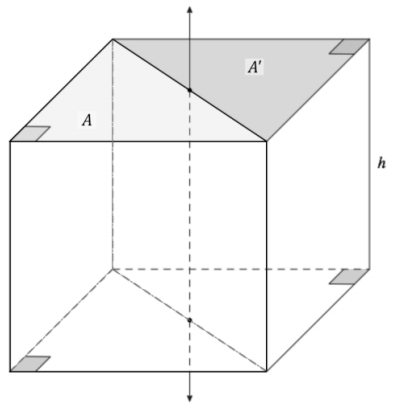
Answer:
The copy of a triangular prism with a right triangle base can be rotated about the axis shown so that the two triangular prisms together form a rectangular prism with volume 2Ah. Since two congruent right triangular prisms together have a volume described by 2Ah, the triangular prism has volume half that value, or Ah.
Eureka Math Geometry Module 3 Lesson 8 Exercise Answer Key
Complete Exercises 1 – 2, and then have a partner check your work.
Exercise 1.
Divide the following polygonal region into triangles. Assign base and height values of your choice to each triangle, and determine the area for the entire polygon.

Answer:
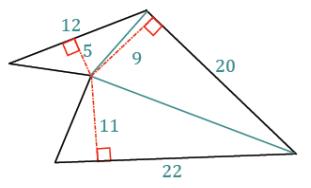
Sample response:
\(\frac{1}{2}\)(12)(5) + \(\frac{1}{2}\)(20)(9) + \(\frac{1}{2}\)(22)(11) = 241
The figure has an area of 241 units2.
Exercise 2.
The polygon from Exercise 1 is used here as the base of a general right prism. Use a height of 10 and the appropriate value(s) from Exercise 1 to determine the volume of the prism.

Answer:
Sample response:
(241)(10) = 2,410
The figure has a volume of 2,410 units3.
Exercise 3.
A square metal plate has a density of 10.2 g/cm3 and weighs 2. 193 kg.
a. Calculate the volume of the plate.
Answer:
2. 193 kg = 2193 g
10.2 = \(\frac{2193}{v}\)
ν = 215
The volume of the plate is 215 cm3.
b. If the base of this plate has an area of 25 cm2, determine its thickness.
Answer:
Let h represent the thickness of the plate in centimeter.
Volume = A · h
215 = 25h
h = 8.6
The thickness of the plate is 8.6 cm.
Exercise 4.
A metal cup full of water has a mass of 1,000 g. The cup itself has a mass of 214.6 g. If the cup has both a diameter and a height of 10 cm, what is the approximate density of water?
Answer:
The mass of the water is the difference of the mass of the full cup and the mass of the empty cup, which is 785.4 g.
The volume of the water in the cup is equal to the volume of the cylinder with the same dimensions.
Volume = Ah
Volume = (π(5)2) · (10)
Volume = 250π
Using the density formula,
density = \(\frac{785.4}{250 \pi}\)
density = \(\frac{3.1416}{\pi}\) ≈ 1
The density of water is approximately 1 g/cm3.
Eureka Math Geometry Module 3 Lesson 8 Problem Set Answer Key
Question 1.
Two congruent solids S1 and S2 have the property that S1 ∩ S2 is a right triangular prism with height and a base that is an equilateral triangle of side length 2. If the volume of S1 ∪ S2 is 25 units3, find the volume of S1.
Answer:
The area of the base of the right triangular prism is and the volume of the right triangular prism is √3 · √3 = 3.
Let x equal the volume of S1 in cubic units. Then, the volume of S2 in cubic units is x.
The volume of S1 ∪ S2 is:
x + x – 3 = 25
x = 14
Therefore the volume of S1 is 14 unitS3 .
Question 2.
Find the volume of a triangle with side lengths 3, 4, and 5.
Answer:
A triangle is a planar figure. The volume of any planar figure is zero because it lies in the plane and, therefore, has no height.
Question 3.
The base of the prism shown In the diagram consists of overlapping congruent equilateral triangles ABC and DGH. Points C, D, E, and F are midpoints of the sides of triangles ABC and DGH. GH = AB = 4, and the height of the prism is 7. Find the volume of the prism.

Answer:
\(\overline{D C}\) connects the midpoints of and \(\overline{A B}\) and \(\overline{G H}\) is, therefore, the altitude of both triangles ABC and DGH. The altitude in on equilateral triangle splits the triangle into two congruent 3 0-60-90 triangles. Using the relationships of the legs and hypotenuse of a 30-60-90 triangle, DC = 2√3.
Volume of triangular prism with bose ABC:
V = \(\frac{1}{2}\)(4 · 2√3) · 7
V = 28√3
The volume of the triangular prism with bose DGH is also 28√3 by the same reasoning.
Volume of parallelogram CEDF:
V = 2 · √3 · 7
V = 14
V(A ∪ B) = V(A) + V(B) – V(A ∩ B)
V(prism) = 28√3 + 28√3 – 14√3
V(prism) = 42√3
The volume of the prism is 42√3 units3.
Question 4.
Find the volume of a right rectangular pyramid whose base is a square with side length 2 and whose height is 1.
Hint: Six such pyramids can be fit together to make a cube with side length 2, as shown in the diagram.

Answer:
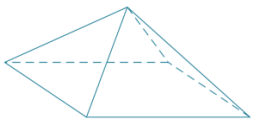
Piecing six congruent copies of the given pyramid together forms a cube with edges of length 2. The volume of the cube is equal to the area of the base times the height:
Volumecube = 22 · 2
Volumecube = 8
Since there are six identical copies of the pyramid forming the cube, the volume of one pyramid is equal to \(\frac{1}{6}\) of the total volume of the cube:
Vp = \(\frac{1}{6}\)(8)
Vp = \(\frac{8}{6}\) = \(\frac{4}{3}\)
The volume of the given rectangular pyramid is \(\frac{4}{3}\) cubic units.
Question 5.
Draw a rectangular prism with a square base such that the pyramid’s vertex lies on a line perpendicular to the base of the prism through one of the four vertices of the square base, and the distance from the vertex to the base plane is equal to the side length of the square base.
Answer:
Sample drawing shown:
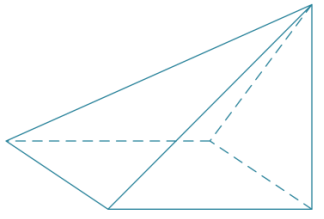
Question 6.
The pyramid that you drew in Problem 5 can be pieced together with two other identical rectangular pyramids to form a cube. If the side lengths of the square base are 3, find the volume of the pyramid.
Answer:
If the sides of the square are length 3, then the cube formed by three of the pyramids must have edges of length 3. The volume of a cube is the cube of the length of the edges, or s3. The pyramid is only \(\frac{1}{3}\) of the cube, so the volume of the pyramid is \(\frac{1}{3}\) of the volume of the cube:
Volume(cube) = \(\frac{1}{3}\) · 33 = 9
The volume of the pyramid is 9 cubic units.
Question 7.
Paul is designing a mold for a concrete block to be used in a custom landscaping project. The block is shown in the diagram with its corresponding dimensions and consists of two intersecting rectangular prisms. Find the volume of mixed concrete, in cubic feet, needed to make Paul’s custom block.

Answer:
The volume is needed in cubic feet, so the dimensions of the block can be converted to feet:
8in. → \(\frac{2}{3}\)ft.
16 in. → 1\(\frac{1}{3}\) ft.
24 in. → 2 ft.
40 in. → 3\(\frac{1}{3}\)ft.
The two rectangular prisms that form the block do not have the same height; however, they do have the same thickness of \(\frac{2}{3}\)ft., and their intersection is a square prism with base side lengths of \(\frac{2}{3}\)ft., so Volume Property 4 can be applied:

Paul will need just over 5 ft3 of mixed concrete to fill the mold.
Question 8.
Challenge: Use card stock and tape to construct three identical polyhedron nets that together form a cube.
Answer:
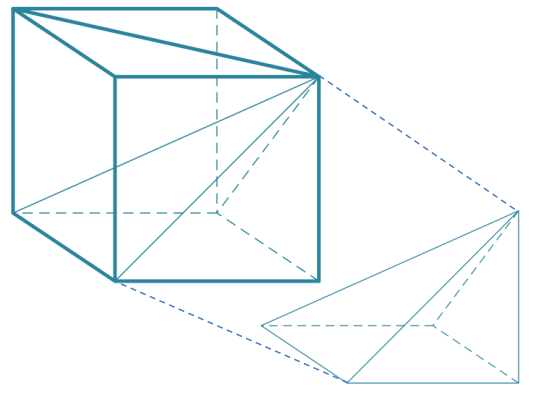
Eureka Math Geometry Module 3 Lesson 8 Exit Ticket Answer Key
The diagram shows the base of a cylinder. The height of the cylinder is 14 cm. If each square in the grid is 1 cm × 1 cm, make an approximation of the volume of the cylinder. Explain your reasoning.
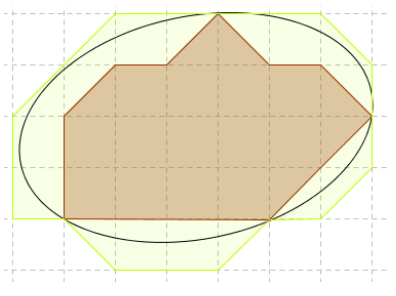
Answer:
By counting the unit squares and triangles that make up a polygonal region lying just within the given region, a low approximation for the area of the region is 16 cm2. By counting unit squares and triangles that make up a polygonal region that just encloses the given region, an upper approximation for the area of the region is 28 cm2. The average of these approximations gives a closer approximation of the actual area of the base.
\(\frac{1}{2}\) (16 + 28) = 22
The average approximation of the area of the base of the cylinder is 22 cm2.
The volume of the prism is equal to the product of the area of the base times the height of the prism.
V = (22 cm2) · (14 cm)
V= 308 cm3
The volume of the cylinder is approximately 308 cm3.